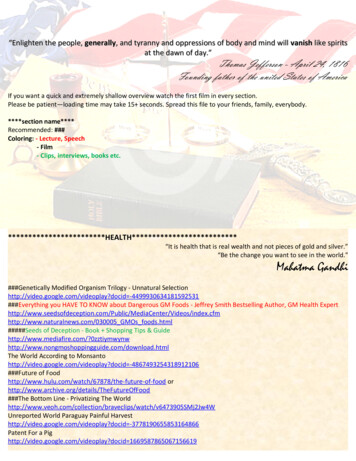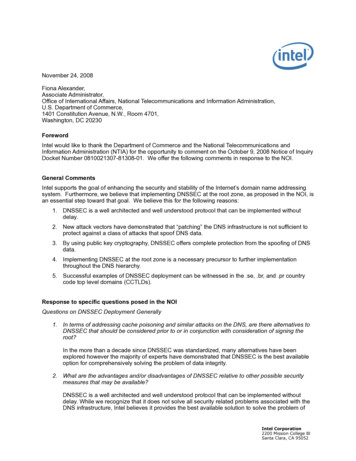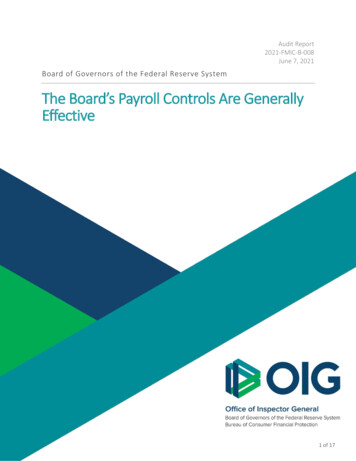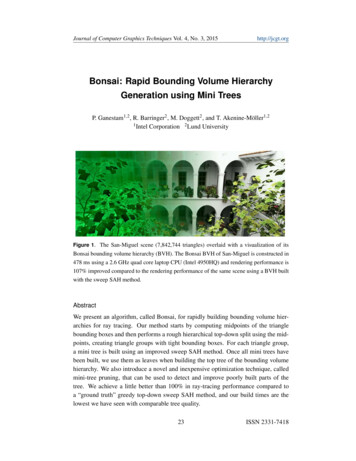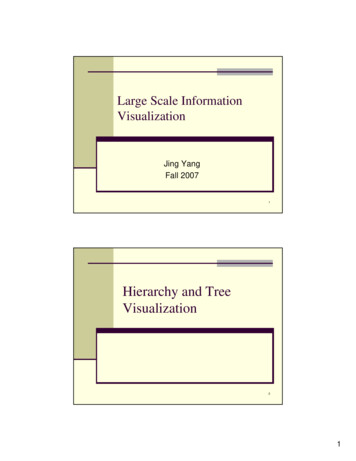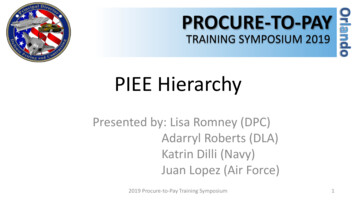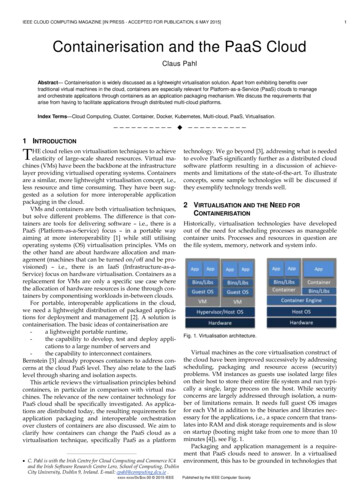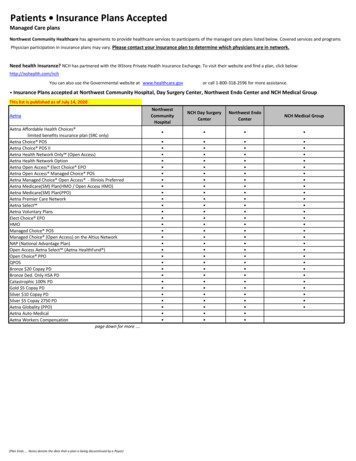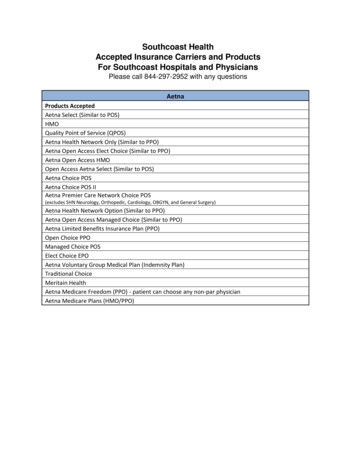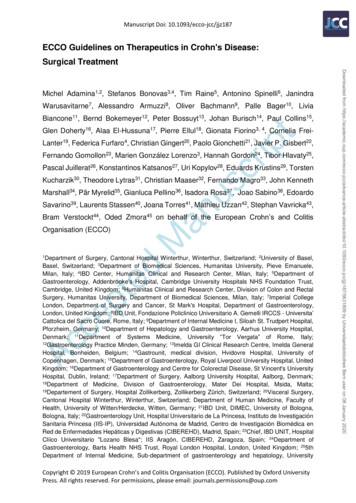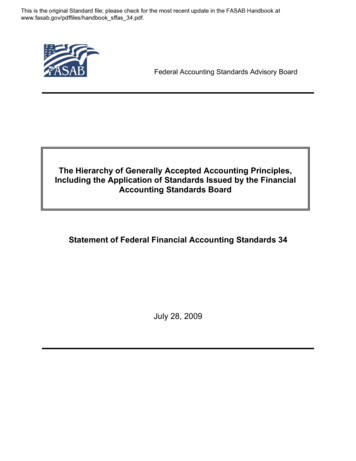
Transcription
This is the original Standard file; please check for the most recent update in the FASAB Handbook atwww.fasab.gov/pdffiles/handbook sffas 34.pdf.Federal Accounting Standards Advisory BoardThe Hierarchy of Generally Accepted Accounting Principles,Including the Application of Standards Issued by the FinancialAccounting Standards BoardStatement of Federal Financial Accounting Standards 34July 28, 2009
This is the original Standard file; please check for the most recent update in the FASAB Handbook atwww.fasab.gov/pdffiles/handbook sffas 34.pdf.THE FEDERAL ACCOUNTING STANDARDS ADVISORY BOARDThe Secretary of the Treasury, the Director of the Office of Management and Budget (OMB),and the Comptroller General, established the Federal Accounting Standards Advisory Board(FASAB or “the Board) in October 1990. FASAB is responsible for promulgating accountingstandards for the United States Government. These standards are recognized as generallyaccepted accounting principles (GAAP) for the Federal Government.An accounting standard is typically formulated initially as a proposal after considering thefinancial and budgetary information needs of citizens (including the news media, state and locallegislators, analysts from private firms, academe, and elsewhere), Congress, Federalexecutives, Federal program managers, and other users of Federal financial information. Theproposed standards are published in an Exposure Draft for public comment. In some cases, adiscussion memorandum, invitation for comment, or preliminary views document may bepublished before an exposure draft is published on a specific topic. A public hearing issometimes held to receive oral comments in addition to written comments. The Board considerscomments and decides whether to adopt the proposed standard with or without modification.After review by the three officials who sponsor FASAB, the Board publishes adopted standardsin a Statement of Federal Financial Accounting Standards. The Board follows a similar processfor Statements of Federal Financial Accounting Concepts, which guide the Board in developingaccounting standards and formulating the framework for Federal accounting and reporting.Additional background information is available from the FASAB or its website: “Memorandum of Understanding among the General Accounting Office, the Departmentof the Treasury, and the Office of Management and Budget, on Federal Government AccountingStandards and a Federal Accounting Standards Advisory Board.” “Mission Statement: Federal Accounting Standards Advisory Board”, Exposure drafts,Statements of Federal Financial Accounting Standards and Concepts, FASAB newsletters, andother items of interest are posted on FASAB’s website at: www.fasab.gov.Federal Accounting Standards Advisory Board441 G Street, NW, Suite 6814Mail stop 6K17VWashington, DC 20548Telephone 202-512-7350FAX – 202-512-7366www.fasab.govThis is a work of the U. S. government and is not subject to copyright protection in the UnitedStates. It may be reproduced and distributed in its entirety without further permission fromFASAB. However, because this work may contain copyrighted images or other material,permission from the copyright holder may be necessary if you wish to reproduce this materialseparately.
This is the original Standard file; please check for the most recent update in the FASAB Handbook atwww.fasab.gov/pdffiles/handbook sffas 34.pdf.Summary3SummaryThe Federal Accounting Standards Advisory Board (FASAB) is the body designated bythe American Institute of Certified Public Accountants (AICPA) as the source ofgenerally accepted accounting principles (GAAP) for federal reporting entities.1 Assuch, the FASAB is responsible for identifying the GAAP hierarchy for federal reportingentities. The GAAP hierarchy consists of the sources of accounting principles and theframework for selecting the principles used in the preparation of general purposefinancial reports2 of federal reporting entities that are presented in conformity withgenerally accepted accounting principles. However, the hierarchy for selecting theprinciples used in the preparation of general purpose financial reports by federalreporting entities was set forth in the AICPA Statement on Auditing Standards (SAS)No. 91, Federal GAAP Hierarchy, rather than in the authoritative literature of theFASAB. This Statement incorporates the hierarchy into the FASAB’s authoritativeliterature.Incorporating the GAAP hierarchy into the authoritative literature of the FASAB is notintended to cause a sudden and dramatic change in practice for federal entities. ThisStatement permits those federal entities currently applying financial accounting andreporting standards issued by the Financial Accounting Standards Board (FASB) tocontinue to do so. In addition, given that the FASAB is the source of GAAP for federalentities, the Statement clarifies that a federal entity that is preparing GAAP-basedgeneral purpose financial reports for the first time is required to implement FASABstandards unless, in consultation with its auditors and bodies with oversight authority,the entity clearly demonstrates that the needs of its primary users would be best metthrough the application of FASB standards.1Statement of Federal Financial Accounting Concepts (SFFAC) 2, Entity and Display, discusses thecriteria for defining federal reporting entities. Also, the terms federal reporting entity and federal entity areused interchangeably throughout this Statement.2The term general purpose financial report is used throughout this Statement as a generic term to refer tothe report that contains the entity’s financial statements that are prepared pursuant to generally acceptedaccounting principles. In the federal government, the report is known as the Performance andAccountability Report or the Agency Financial Report.Federal Accounting Standards Advisory BoardThe Hierarchy of Generally Accepted Accounting Principles, Including the Application ofStandards Issued by the Financial Accounting Standards BoardJuly 28, 2009
This is the original Standard file; please check for the most recent update in the FASAB Handbook atwww.fasab.gov/pdffiles/handbook sffas 34.pdf.Table of Contents4Table of ContentsSummary. 3Introduction . 5Purpose . 5Materiality . 5Effective Date . 6Accounting Standards . 7Scope . 7The Hierarchy of Generally Accepted Accounting Principles. 7Other Accounting Literature. 8Application of Standards Issued by the Financial Accounting Standards Board. 9Effective Date . 10Appendix A: Basis for Conclusions . 11Project History . 11Application of Standards Issued by the Financial Accounting Standards Board. 11Application to Legislative and Judicial Branches . 12Exposure Draft. 13Clarifying the GAAP Hierarchy and Other Accounting Literature . 14Entities Following FASB GAAP . 15Board Approval . 16Appendix B: Abbreviations . 17Appendix C: Glossary. 18Federal Accounting Standards Advisory BoardThe Hierarchy of Generally Accepted Accounting Principles, Including the Application ofStandards Issued by the Financial Accounting Standards BoardJuly 28, 2009
This is the original Standard file; please check for the most recent update in the FASAB Handbook atwww.fasab.gov/pdffiles/handbook sffas 34.pdf.Introduction5IntroductionPurpose1. The objective of this Statement is to identify the sources of accountingprinciples and the framework for selecting the principles used in thepreparation of general purpose financial reports of federal reporting entities3that are presented in conformity with generally accepted accounting principles(the GAAP hierarchy).a. This Statement responds to a request from the American Institute ofCertified Public Accountants (AICPA) that FASAB incorporate the GAAPhierarchy, which currently resides in the professional auditing literature,into the accounting literature.b. This Statement also addresses (1) whether federal entities currentlyapplying standards issued by the Financial Accounting Standards Board(FASB) may continue that practice, and (2) whether federal entities thatare preparing GAAP-based general purpose financial reports for the firsttime may also apply FASB standards.Materiality2. The provisions of this Statement need not be applied to immaterial items. Thedetermination of whether an item is material depends on the degree to whichomitting or misstating information about the item makes it probable that thejudgment of a reasonable person relying on the information would have beenchanged or influenced by the omission or the misstatement.3Statement of Federal Financial Accounting Concepts 2, Entity and Display, provides criteria foridentifying federal reporting entities. In addition, the Board is currently developing standards defining thefederal reporting entity.Federal Accounting Standards Advisory BoardThe Hierarchy of Generally Accepted Accounting Principles, Including the Application ofStandards Issued by the Financial Accounting Standards BoardJuly 28, 2009
This is the original Standard file; please check for the most recent update in the FASAB Handbook atwww.fasab.gov/pdffiles/handbook sffas 34.pdf.Introduction6Effective Date3. The requirements in this standard are effective upon its issuance.Federal Accounting Standards Advisory BoardThe Hierarchy of Generally Accepted Accounting Principles, Including the Application ofStandards Issued by the Financial Accounting Standards BoardJuly 28, 2009
This is the original Standard file; please check for the most recent update in the FASAB Handbook atwww.fasab.gov/pdffiles/handbook sffas 34.pdf.Accounting Standards7Accounting StandardsScope4. This Statement applies to the general purpose financial reports of all federalreporting entities that are presented in conformity with generally acceptedaccounting principles (GAAP).4The Hierarchy of Generally Accepted Accounting Principles5. The hierarchy of generally accepted accounting principles, hereafter referredto as the GAAP hierarchy, governs what constitutes GAAP for federalreporting entities. It lists the priority sequence of pronouncements that afederal reporting entity should look to for accounting and financial reportingauthoritative guidance. The sources of accounting principles that aregenerally accepted are categorized in descending order of authority asfollows:a. Officially established accounting principles consist of FASAB Statementsof Federal Financial Accounting Standards (Standards) andInterpretations. FASAB Standards and Interpretations will be periodicallyincorporated in a publication by the FASAB.b. FASAB Technical Bulletins and, if specifically made applicable to federalreporting entities by the AICPA and cleared5 by the FASAB, AICPAIndustry Audit and Accounting Guides.6c. Technical Releases of the Accounting and Auditing Policy Committee ofthe FASAB.4The AICPA has designated the FASAB as the source of GAAP for federal reporting entities. Therefore,FASAB GAAP would be the appropriate accounting standards for federal reporting entities in theexecutive, legislative, and judicial branches.5For purposes of interpreting category (b), the word cleared means that the FASAB does not object to thepronouncement’s issuance.6Such pronouncements specifically made applicable to federal reporting entities are presumed to havebeen cleared by the FASAB, unless the pronouncement indicates otherwise.Federal Accounting Standards Advisory BoardThe Hierarchy of Generally Accepted Accounting Principles, Including the Application ofStandards Issued by the Financial Accounting Standards BoardJuly 28, 2009
This is the original Standard file; please check for the most recent update in the FASAB Handbook atwww.fasab.gov/pdffiles/handbook sffas 34.pdf.Accounting Standards8d. Implementation guides published by the FASAB staff, as well aspractices that are widely recognized and prevalent in the federalgovernment.6. If the accounting treatment for a transaction or event is not specified by apronouncement in category (a), a federal reporting entity should considerwhether the accounting treatment is specified by an accounting principle froma source in another category. In such cases, if categories (b)–(d) containaccounting principles that specify accountin
that are presented in conformity with generally accepted accounting principles (the GAAP hierarchy). a. This Statement responds to a request from the American Institute of Certified Public Accountants (AICPA) that FASAB incorporate the GAAP hierarchy, which currently resides in the professional auditing literature, into the accounting literature. b. This Statement also addresses (1) whether federal entities File Size: 331KBPage Count: 19
